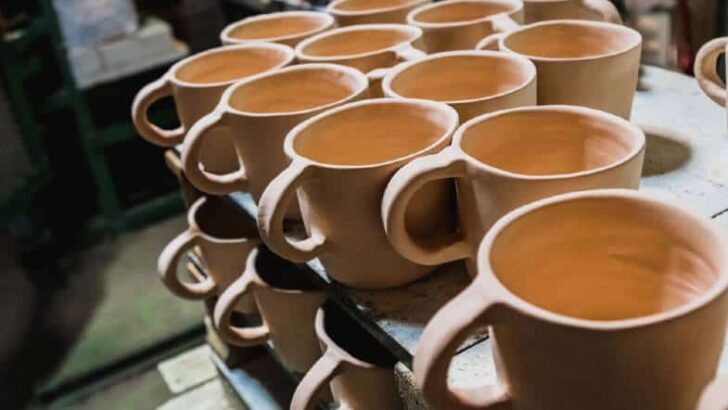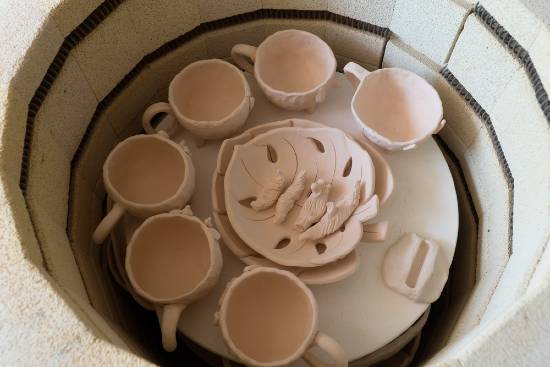Your cart is currently empty!
What is the First Firing of Clay Called?
Published:
Last Updated:

Affiliate Disclaimer
As an affiliate, we may earn a commission from qualifying purchases. We get commissions for purchases made through links on this website from Amazon and other third parties.
One of the first things that you will learn about firing clay is that it happens in two stages. These two stages have different purposes. This article is all about the first stage. So, let’s look first at what the first firing of clay is called…
The first firing of clay is called the bisque fire. It is also sometimes called the biscuit fire. Bisque is the most common term used to refer to the first firing of clay. And nowadays the terms bisque and biscuit are used interchangeably. However, they had a slightly different meaning originally.
In this article, I will look at a few different terms that are used for the first firing of clay. And I will tease out some of the differences.

What is the First Firing of Clay Called?
Most often when potters talk about the first firing of clay, they use the term bisque fire. During the bisque fire clay is transformed from raw greenware clay to ceramic material.
Greenware clay is fragile and breaks easily. It is also soluble, so if it gets wet, the solid greenware will start to dissolve.
The ceramic ware that is produced by a bisque fire is hard and porous. That means that if it gets wet it will absorb water. But it does not dissolve.
The most common terms for clay produced by the bisque fire is bisqueware, bisque, or bisque ware. Once clay has gone through the change from greenware to bisque ware it can’t be turned back into clay.
The term ‘bisque’ firing is usually used by potters to refer to any firing of unglazed pottery. Once the pots have been through this first firing, glaze is applied in preparation for the glaze fire.
However, strictly speaking, the term ‘bisque fire’ has a particular meaning.
What does Bisque Fire Mean?
Bisque firing is when the first firing of clay is at a higher temperature than the later glaze fire. Just to mix things up further, another term for bisque, is ‘bisc’.
Normally, the first firing of clay reaches temperatures of around 1832F (1000C). To be more precise, potters normally fire greenware clay to 1823F (995C) or 1940F (1060C).
These temperatures equate to cones 06 and 04 on the Orton Cone Chart. The cone system is a shorthand way of referring to the temperature and time it takes to fire clay. To know more about cones in pottery, check out this article.
In the strict sense of the word, pottery being bisque fired would be fired at a high temperature. Then followed by a glaze fire at a lower temperature.
This is common practice in the industrial production of ceramics. In industry, a bisque fire might be at 2282F (1250C), and the glaze fire might be 1976F (1080C).
The higher the temperature of the bisque fire, the harder the bisque ware. For example, clay fired to 1823F will be softer and more porous than clay fired at 1940F.
Why Bisque Fire at a Higher Temperature ?
Some reason for bisque firing at a higher temperature include:
- The ceramic ware is harder and less likely to break when being handled
- More of the carbons and impurities in the clay will be burned out in the bisque fire. All clay contains carbons. If these aren’t burned out in the bisque fire, they create gases that ruin pottery glaze in the glaze fire.
These are known as glaze defects and include blisters and pinholes in the glaze. And bloated clay.
It is for these reasons that bisque firing at a higher temperature is common practice in industrial pottery production. It’s also common practice in schools where art teachers want to minimize the chance of glaze defects.

In spite of these advantages, there are some drawbacks to bisque firing at a higher temperature. The main drawback is that higher temperatures in a bisque fire make the bisque ware less porous. This means that it is less absorbent.
Pottery glaze contains a lot of water. When it is applied to porous bisque, the bisque ware quickly draws water out of the glaze. This leaves behind a layer of glaze materials on the pottery surface, ready for the glaze fire.
If the bisque ware is not especially porous it can be hard to get a thick enough layer of glaze on the pot. When the pot is fired the glaze can look washed out, streaky, or uneven.
This is one reason why potters often choose to bisque fire at a lower temperature than the glaze fire.
What Does Biscuit Fire Mean?
The term ‘biscuit’ firing is less commonly used these days. Strictly speaking, it refers to when the first firing of clay happens at a lower temperature than the glaze fire.
Biscuit firing at lower temperatures has the advantage of being more porous. This makes glaze application easy, as the porous bisque easily absorbs water from the glaze.
However, there is a trade-off between porosity and strength. The term ‘soft biscuit’ is used to refer to clay that has been fired to lower temperatures.
Biscuit fired pottery is softer than bisque ware because of the changes that clay goes through when it’s fired. As clay is fired, it goes through important physical and chemical changes.
During these changes, the clay particles move closer to one another and the clay becomes denser. Part of this process involves the bonding together of parts of the clay particle’s surface that are touching each other.
Eventually, at higher temperatures, the gaps between the clay particles become filled with a glassy substance made from silica.
However, at lower temperatures, the gaps between the clay particles are still quite large, and the bonds are weaker. This means that low fired biscuit is less strong than pottery that has been bisque fired at a higher temperature.
Interestingly, the term ‘biscuit’ when used in ceramics comes from the Old French word ‘bescuit’, which means cooked twice. Edible biscuits were baked in the oven once, then dried a second time in the oven to preserve them.
The First Firing of Clay – Final Thoughts
These days the term ‘bisque firing’ is most often used to refer to the first firing of clay. The pottery produced by the bisque fire is bisque ware, bisqueware, or bisque. Potters do sometimes refer to the first firing of clay as the biscuit fire, producing biscuit ware. The term biscuit has a somewhat quaint traditional feel to me. But maybe that’s my own prejudice! Bisque and biscuit are often used more or less interchangeably. However, they do have somewhat different original meanings.



